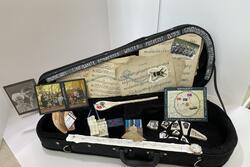Inviting Ushpizot into Your Sukkah Is One Tradition You Won't Have to Skip This Year
When it comes to Sukkot, much can be gleaned about the holiday from its name. A sukkah (plural sukkot) is a temporary structure built outside to remind us of the Exodus from Egypt. While according to the Tanakh, it is a place to “rejoice before God” (Lev. 23:40), the sukkah is just as much a place to rejoice with guests. In fact, hachnasat orchim (welcoming guests) is a prominent part of celebrating the holiday. Family, friends, and neighbors are often invited to share food and drink. Though it’s a mitzvah to host guests and an honor to be hosted, this year, the pandemic complicates this tradition.
Although guests can’t physically be invited into sukkot this year, there are ways (besides Zoom) to fulfill the meaningful tradition. The ushpizin and ushpizot, meaning “patriarchal and matriarchal guests” in Aramaic, are biblical figures that have traditionally been symbolically invited and invoked on each of the eight nights of the holiday.
The Zohar, a kabbalistic text written in thirteenth century Spain, created the practice of ushpizin by linking each patriarch to a different sefirah and encouraging a new guest to “visit” each evening of the holiday. The ushpizot are a more recent custom. Often (though not always) they are the seven prophetesses listed in the Talmud: Sarah, Miriam, Deborah, Hannah, Abigail, Huldah, and Esther.
Each of these women played an active role in the story of the Jewish people. Sarah left her homeland with her husband, Abraham, and after struggling with both infertility and God, gave birth to Isaac. Without her, there would have been no next generation, and the Jewish journey would have ended there. Miriam helped save her younger brother, Moses, led the Israelite women in dance and song after they successfully left Egypt, and provided water that sustained them in the desert. Deborah was not only a prophet, but also a judge and military hero. Hannah’s moving pleas to God for a son succeeded and continue to impact how Jewish communities pray today. Abigail treated not-yet-King David with hospitality. Huldah was a temple prophetess who validated a scroll of law. Esther, the Purim heroine, saved the Jews of Persia from a certain death with her wit and beauty.
The custom of ushpizot is one that has evolved and is still evolving. For those who want to honor prominent Jewish women from Jewish texts, acknowledging the ushpizot is a wonderful tradition to embrace this Sukkot. Yet, the ushpizot are not the only Jewish women who can be honored during the holiday. We can fulfill this ritual by honoring other Jewish women makers and shakers as well.
Some synagogues, communities, and families have a custom of symbolically inviting contemporary or historical Jewish women into the sukkah along with the ushpizot. There are so many noteworthy and remarkable Jewish women that the hardest part of this innovative ritual may be deciding which women to acknowledge and learn about this year.
More commonly invited women include prominent Jewish leaders, thinkers, activists, and heroines from the last 100 to 200 years. These women include political philosopher Hannah Arendt, Supreme Court Justice Ruth Bader Ginsburg, inventor and actress Hedy Lamarr, and scientist Rosalind Franklin.
Yet you can invite whichever honorary guests you want into your sukkah. The invitation is not literal; rather, it’s an opportunity to engage more deeply with the lives and legacies of Jewish women. In order to narrow down whom you want to honor, the following questions might be helpful: What values do I want to teach to those gathered in my sukkah? Which fields (science, politics, religion, philosophy, engineering, business, etc.) do I want to highlight? Are there Jewish women whose stories are often overlooked by mainstream Jewish institutions and narratives that I want to include? How do I want to highlight the diversity of Jewish women and their experiences in the present day and throughout history?
To really bring these women into the sukkah (or into the home if you don’t have a sukkah), you (and whoever you’re living with) can make posters with their pictures and even short biographies, reminiscent of ushpizin posters that decorate a sukkah. You could borrow and/or purchase books about them; from picture books to longer academic tomes, there are options for every reading level. In the case of the ushpizot and biblical figures, you can find and/or make a source sheet, which is a document full of passages from religious and even non-religious texts that tell their story. And on those cold or rainy nights when indoor celebration is more appropriate than outdoor, documentaries and movies can provide additional learning opportunities.
Though hachnasat orchim is difficult to practice this year, Sukkot need not be lonely. In addition to members of the household and/or quarantine pod, you can invite numerous Jewish women from the Torah, history, and the present day. Maybe it will even become a new tradition, and generations from now, friends and families will be inviting the “new” ushpizot as well as the older, kabbalistic visitors.
May whatever form guests take this year bring us joy and happiness—sukkot sameach!







